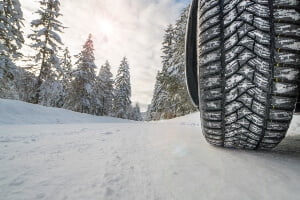 As we get closer to Christmas and winter arrives in Pennsylvania, it is time to start thinking about winter driving.
As we get closer to Christmas and winter arrives in Pennsylvania, it is time to start thinking about winter driving.
Snow-covered roads, icy patches, and reduced visibility can make winter driving a challenge. Here are some suggestions to help you stay safe this winter:
Getting Your Vehicle Winter Ready
To be sure your vehicle is ready to handle the roads this winter, there are a few things you need to do:
- Put winter tires on your vehicle: If you do not have good all-weather tires, then consider purchasing winter tires. Having good tires can significantly improve your vehicle’s traction on snow and ice.
- Check your vehicle’s battery: Cold weather can strain your car’s battery and you do not want it to go dead on a cold wintery night.
- Top up your anti-freeze: Be sure you maintain antifreeze levels all winter to prevent your engine’s cooling system from freezing.
- Brakes: Get your braking system checked to make sure everything is in good working order.
- Vehicle lights: Check all vehicle lights to make sure they are working properly, including your headlights and turn signals, as well as your brake and taillights.
- Fluids: Make sure all essential fluids, such as engine oil and windshield washer fluid, are at the recommended levels.
Before Going Out on the Road
It is a good idea to avoid driving in severe winter weather, but when it cannot be avoided, there are some additional safety tips we recommend. To start with, stick to primary roads whenever possible, because these are usually cleared of snow and ice first.
Another important reminder is that driver safety in winter takes a little more time, so be sure to allow an extra 20 minutes or more, depending on the weather conditions. Some steps we recommend taking before going out on the road include:
Clear Away Snow and Ice
Be sure to warm up your vehicle, as this makes ice removal easier. Be sure to clear away all snow and ice away, including from the top and hood of your car. Snow could blow from the top of your car and hit another vehicle behind you, temporarily blinding that driver’s field of vision. You should also be sure ice and snow are fully cleared away from all windows, mirrors and lights on your vehicle.
Put Emergency Items in Your Vehicle
Some helpful items to have in case of an emergency include:
- Emergency blanket
- Flares
- Working flashlight
- Portable charger for your cellphone
- Water
- First aid kit
- Emergency triangles
These items can help you whether your vehicle gets stuck or breaks down during snowy or stormy winter weather.
Make Sure All Your Lights Are Working and Use Them
Be sure to turn on your headlights during snow storms and other inclement weather, even during daylight hours. This can help you to see the road better and it always increases your visibility to other drivers, which can help to keep you safer on the road.
When turning or changing lanes, be sure to signal well in advance. This is a simple but effective way to alert other drivers that you are about to make a maneuver that could be in their path. Turn signals, when used properly, can help to avoid a serious crash.
Driving
When driving in winter weather, the road conditions can be unexpected. Hazards, such as black ice, can cause drivers to skid out of control and crash. Heavy snow or foggy conditions can greatly decrease visibility. Drivers owe a legal duty of care, even in bad weather, which means those who cause a crash during these road conditions are still held liable for the damages.
While you cannot control what other drivers may do, you can choose to take reasonable steps to avoid causing harm to yourself or others by:
- Reducing your speed: Slow down when driving in winter conditions. Snow and ice can reduce traction, so you need to exercise more care when braking and allow more time to stop.
- Increase following distance: Maintain a safe following distance from the vehicle in front of you so you have more reaction time to unexpected hazards, such as a reckless driver suddenly darting into your lane. A safe following distance on icy or snow-covered roads is going to be longer than on clear, dry roads, so be sure to keep that in mind.
- Avoid cruise control: Disable cruise control when driving on slippery surfaces. Maintaining manual control over your speed and acceleration is essential for safely navigating unpredictable winter conditions.
- Be extra cautious on bridges and overpasses: These areas tend to freeze first, so approach them at slower speeds and with extra caution.
- Avoid distractions: There are all kinds of dangerous distractions you should avoid while driving, especially when driving on wet, snowy or icy roads. Whether this means putting away your cellphone, turning off your radio or asking passengers to be quiet, your focus should be on the road and your driving.
The legal team at Schmidt Kramer wish you, your family and your friends a safe holiday season and safety on Pennsylvania roads this winter.
If you suffer an injury in a wintertime car crash, Schmidt Kramer may be able to help you seek compensation for your damages.
No upfront costs. Free consultation. Call us at (717) 727-2550.

